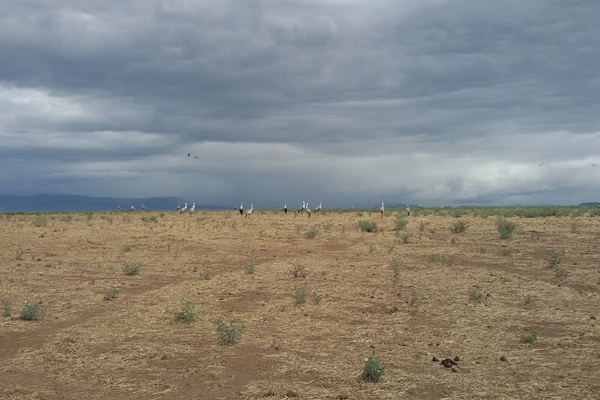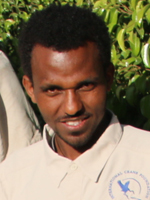“Congratulations. I am thrilled that you found such a substantial population of Wattled Cranes.” ~ George
Our Co-founder, George Archibald, wrote this note of congratulations to International Crane Foundation Research Associate, Hadis Tadele, after he discovered a possible new population of Wattled Cranes in Ethiopia. This discovery reminds us that there is still much to learn about cranes and their conservation – we hope that you will enjoy reading more about this experience in Hadis’ words:

“I was at the Melka Wakena reservoir in south-central Ethiopia for the last three and a half days undertaking a full survey of Wattled Cranes.
On the first day of the survey, it took several hours before we sighted any cranes. At about 1:00 p.m. I observed three Wattled Cranes from a distance, and I felt so happy!
As I got closer to the cranes, I saw that they were feeding on a grassland. I continued to search for more cranes, and at some distance, I observed a big flock. As I got closer and started counting the number, I realized that it was huge number – I haven’t observed such a large flock in 1-square kilometer before, even in Boyo wetland.
The number was 166 + 3= 169 Wattled Cranes, which is the largest one-stop count of Wattled Crane ever made in Ethiopia. I can’t explain to you how happy I was when I found them. I decided to come back the next day and confirm the number and find out if there were more cranes in the area. On the first day, I didn’t make a juvenile count; I don’t know why? Maybe because I was so happy, I forget to do so.

The next day, we got up early in the morning and went to the reservoir. We found the flock again in the same location, but they were all in the adjacent farmland feeding on the waste grain of wheat. The farmland is a vast area of state farm owned by the government, and it is free of disturbance, so the cranes were feeding without any danger. Then I made a complete survey of the population, and the total number was perfectly the same as the previous day.
169 total population = 160 adults and nine juveniles.
Beside this, I also interviewed local communities in the area. Many of the locals have known about the cranes for a long time (30 years). Some of the old people told me that according to the Oromo culture Wattled Cranes are a sign of rain, meaning that when they come to their farm for feeding, it means rain is coming.
But, I am not sure whether this population is a new population. I am going to Boyo wetland today to undertake a crane survey and collect other ecological data.
I am so happy for making this comprehensive ground survey of Wattled Cranes and to be part of this discovery. I have attached some pictures of Wattled Cranes with their juveniles while they were feeding, as well as to show what the area looks like.”
 Story submitted by Hadis Tadele, Research Associate for the International Crane Foundation. Click here to learn more about our work in Sub-Saharan Africa.
Story submitted by Hadis Tadele, Research Associate for the International Crane Foundation. Click here to learn more about our work in Sub-Saharan Africa.
